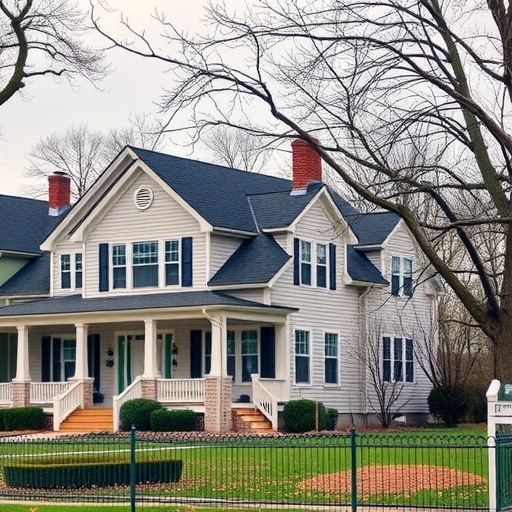U.S. Foreclosures Skyrocket as Politicians Ignore Housing Crisis Ahead of 2026 Midterms
In a stark reminder of the fragility of the American Dream, foreclosure filings across the United States surged by 25% in the third quarter of 2023, according to the latest data from ATTOM, a leading provider of real estate analytics. This alarming spike, the highest in over a decade, is leaving millions of families teetering on the edge of homelessness even as lawmakers in Washington focus on partisan battles rather than the escalating housing crisis. With the 2026 midterm elections looming, critics from both sides of the aisle are sounding the alarm that U.S. politics is failing to address a problem that could redefine the nation’s economy.
- Foreclosure Filings Explode in Heartland and Coastal Hotspots
- Bipartisan Blind Spot: How Democrats and Republicans Are Failing Families
- Real Lives Upended: Stories from the Foreclosure Frontlines
- Economic Fallout: Foreclosures Threaten National Recovery
- Midterm Pressure Mounts: Will Voters Force Housing Reform?
The numbers paint a grim picture: over 93,000 properties received foreclosure filings between July and September, up from 74,000 in the same period last year. States like Florida, Texas, and Illinois are bearing the brunt, with urban centers seeing the most distress. This isn’t just a statistic—it’s a human tragedy unfolding in neighborhoods from Miami to Chicago, where rising interest rates, stagnant wages, and post-pandemic economic fallout are pushing homeowners into desperation.
Foreclosure Filings Explode in Heartland and Coastal Hotspots
The Foreclosures wave is hitting hardest in regions once touted as economic powerhouses. In Florida, filings jumped 45% year-over-year, driven by skyrocketing insurance costs and hurricane recovery burdens. Miami-Dade County alone reported over 5,000 new cases, many tied to adjustable-rate mortgages that reset at unaffordable levels after the Federal Reserve’s aggressive rate hikes.
Texas isn’t far behind, with Houston seeing a 30% increase as oil-dependent families grapple with volatile energy prices. “We’ve got folks who bought homes at the peak of the market in 2021, and now with job losses in the sector, they’re underwater on their loans,” said Elena Ramirez, a housing advocate with the Texas Tenants’ Union. Her organization has fielded a 60% uptick in calls from distressed homeowners since summer.
In the Midwest, Illinois leads with Chicago’s foreclosure rate climbing 28%, exacerbated by commercial real estate slumps spilling over into residential markets. Nationally, the Mortgage Bankers Association reports that delinquency rates for conventional loans reached 3.9% in Q3, the highest since 2011. These trends underscore a deepening housing crisis that threatens to unravel community fabrics, with minority and low-income households disproportionately affected—Black and Latino families facing eviction risks at twice the rate of white counterparts, per Urban Institute data.
Economists warn that without intervention, this surge could cascade into broader instability. “Foreclosures don’t just displace families; they drag down property values, strain local governments, and erode consumer confidence,” noted Dr. Sarah Kline, an economics professor at Georgetown University. Her research highlights how the 2008 crisis led to a 20% drop in median home prices in affected areas—a scenario that could repeat if the current foreclosures trend persists.
Bipartisan Blind Spot: How Democrats and Republicans Are Failing Families
As the foreclosures numbers climb, accusations of neglect are flying in U.S. politics. Both major parties stand accused of prioritizing election-year posturing over substantive housing reform. Democrats, who control the White House and Senate, have touted initiatives like the Build Back Better agenda, but critics argue these fall short. “We’ve seen billions allocated for infrastructure, yet only crumbs for direct homeowner relief,” said Rep. Marcus Hale (D-CA), a moderate Democrat who broke ranks to criticize his party’s approach in a recent op-ed.
On the Republican side, opposition to federal spending has blocked key bills, including expansions to the Homeowner Assistance Fund (HAF), which provided $10 billion in aid but is now depleted. Senate Minority Leader Mitch McConnell dismissed additional funding as “fiscal irresponsibility” during a September floor speech, even as his home state of Kentucky reports a 15% rise in rural foreclosures. GOP lawmakers in red states like Ohio and Georgia have pushed tax cuts for corporations while resisting rent control or foreclosure moratoriums, leaving vulnerable constituents exposed.
A joint report from the Bipartisan Policy Center reveals that since 2021, only 12% of proposed housing bills have passed Congress, compared to 35% for defense spending. “This housing crisis is a bipartisan failure,” the report states bluntly. Housing experts like those at the National Low Income Housing Coalition point to stalled legislation, such as the End Veteran Homelessness Act, which could have prevented thousands of military family evictions but languishes in committee.
Public frustration is boiling over. A recent Gallup poll shows 62% of Americans view the economy as their top concern, with housing affordability ranking second. Yet, in campaign trail speeches ahead of the 2026 midterms, candidates from both parties have largely sidestepped the issue, focusing instead on inflation and border security.
Real Lives Upended: Stories from the Foreclosure Frontlines
Behind the data are harrowing personal narratives that humanize the housing crisis. Take Maria Gonzalez, a single mother in Las Vegas, Nevada, where foreclosures rose 35% this quarter. After losing her job as a casino hospitality worker during a slowdown, Gonzalez’s mortgage payments ballooned from $1,200 to $1,800 monthly. “I fought it for months, but the bank won,” she told reporters outside her foreclosed home last week, tears streaming as movers carted away her belongings. Her family of four now faces temporary shelter, joining over 500,000 Americans at risk of homelessness due to housing instability, per HUD estimates.
In Detroit, Michigan—a city still scarred by the 2008 crash—veteran auto worker Jamal Thompson shares a similar plight. With GM layoffs hitting his plant, Thompson’s credit score tanked, triggering a foreclosure notice. “I served two tours in Iraq for this country, and now I’m losing my home because politicians can’t agree on basic relief,” he vented in an interview with local news affiliate WXYZ. Advocacy groups report a 40% increase in such veteran cases nationwide, prompting calls for targeted VA loan protections.
These stories aren’t isolated. In California, where foreclosures spiked 22% amid wildfires and high living costs, immigrant families are hit hardest. The California Housing Partnership notes that non-citizen households face barriers to aid programs, leading to a “silent eviction wave.” One such family, the Patels from Fresno, saw their dairy farm foreclosed after medical bills mounted. “We came here for opportunity, not this,” said father Raj Patel, echoing sentiments from thousands in similar straits.
Social services are overwhelmed. Food banks in foreclosure-heavy areas like Atlanta report a 50% demand surge, while mental health hotlines log increased calls from stressed homeowners. “The emotional toll is immense—depression, anxiety, even suicides linked to financial ruin,” said Dr. Lisa Chen, a psychologist specializing in economic trauma at Johns Hopkins. Her clinic has seen a 30% patient increase since the foreclosures uptick began.
Economic Fallout: Foreclosures Threaten National Recovery
The ripple effects of this foreclosures surge extend far beyond individual homes, posing risks to the broader economy. Zillow’s latest housing report estimates that widespread foreclosures could shave 0.5% off GDP growth in 2024 by curbing consumer spending and local tax revenues. Banks, too, are bracing: JPMorgan Chase set aside $1.2 billion for potential loan losses in Q3, signaling Wall Street’s worry.
Real estate markets are cooling rapidly in affected areas. In Phoenix, Arizona, where filings rose 32%, home sales dropped 15% as buyer hesitation grows amid falling values. “It’s a vicious cycle: foreclosures flood the market with distressed properties, depressing prices and deterring investment,” explained realtor analyst Tom Hargrove of Redfin. Commercial sectors feel it too—strip malls near foreclosed neighborhoods see vacancy rates climb, hurting small businesses.
On the macro level, the Federal Reserve’s rate policy is under scrutiny. Chair Jerome Powell acknowledged in a September presser that “housing distress is a concern,” but stopped short of signaling cuts. Critics, including former Treasury Secretary Larry Summers, argue for targeted interventions like principal reductions. Meanwhile, inflation hawks in Congress resist, fearing it could reignite price pressures.
Globally, the U.S. housing crisis is drawing parallels to Europe’s property woes, with the IMF warning in its World Economic Outlook that American foreclosures could dampen international trade if they stall recovery. Domestically, job markets in construction and finance—key to 10 million positions—are vulnerable, per Bureau of Labor Statistics projections.
Midterm Pressure Mounts: Will Voters Force Housing Reform?
As the 2026 midterms approach, the housing crisis is emerging as a potential flashpoint in U.S. politics. Voter turnout models from Pew Research suggest that economic issues like affordability could mobilize younger and minority demographics, who polls show are 70% more likely to prioritize housing in their ballots. In swing states like Pennsylvania and Wisconsin, where foreclosures have risen 20-25%, grassroots campaigns are gaining traction.
Activists are pushing for change. The national “Homes for All” coalition, backed by 200 organizations, plans protests at the Capitol in November, demanding a $100 billion housing trust fund. “If politicians don’t act now, the ballot box will,” warned coalition director Aisha Rahman. Early fundraising data shows housing-focused PACs raising $50 million, targeting incumbents who ignored the issue.
Looking ahead, experts foresee a pivotal 2025 legislative session. Bipartisan talks on extending HAF and incentivizing affordable builds could gain momentum if foreclosures continue unchecked. States like New York are experimenting with local solutions—Governor Kathy Hochul’s $5 billion plan includes foreclosure mediation programs that have already saved 10,000 homes. Federally, a proposed “Housing Security Act” aims to cap interest rate resets and expand credit counseling, but its fate hinges on midterm outcomes.
For the millions affected, the clock is ticking. Without swift action, the economy‘s fragile rebound could falter, turning a policy oversight into a generational setback. As one evicted family in Orlando put it, “This isn’t just about houses—it’s about hope.” The question now is whether Washington will listen before the crisis consumes more American dreams.










